Tuesday, March 2 and Wednesday, March 3
Paula and Steve: On Tuesday morning, we flew from Bangkok
to Luang Prabang. Luang Prabang is located in the northern part of Laos and
known for its historic temples and beautiful setting. In 1995, Luang Prabang
was designated a UNESCO World Heritage Site and tourism quickly became important
to this small community of only 30,000 residents. Several people have highly
recommended that we spend time here, as Laos has not yet been modernized or
taken over by tourism. This is a quiet country, with its people living very
simple and traditional lives. We also knew that we'd be ready for a low-key
destination at this point of our travels.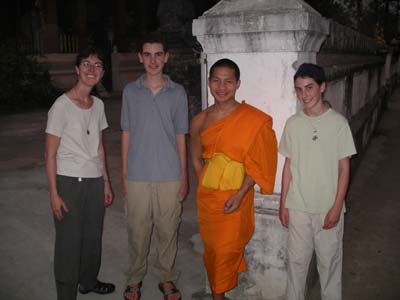
After arriving and getting oriented (this is a very small place, so it didn't take long), we spent our first afternoon exploring the town's main street on our own. While we were a bit surprised to see so many tourist shops and restaurants, we also immediately embraced the low key atmosphere of this community along the Mekong River. Luang Prabang sits on a small peninsula, and is wide enough for only 4 streets to traverse its length. We quickly realized that only the main street is geared toward the tourists - walking in the other areas gives a good indication of what real life here is all about.
There are 35 Buddhist monasteries in Luang Prabang and many are located right
in the center of the town. As we walked by one of the monasteries, we were
engaged in a conversation by a "novice" (student training to become
a monk) who spoke excellent English. He had only studied English for one year
but was able to tell us about his family, where he was from, and what he was
studying at the monastery.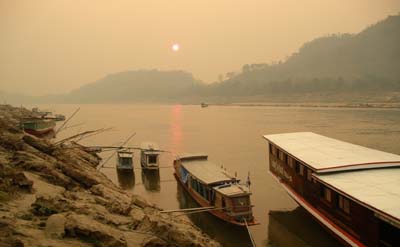
During the evening, we also enjoyed watching the sun set over the Mekong
River and its many long boats. Our small hotel sits right on the Mekong and
our balconies afford wonderful views of the river. We plan to take a boat
trip later in the week to help us understand life along this vital river which
runs through China, Myanmar, Laos, Cambodia and Vietnam.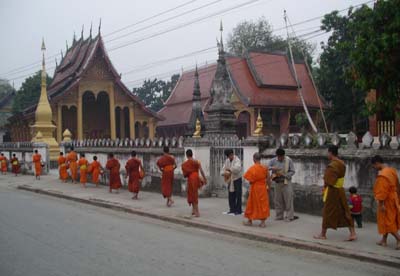
On Wednesday, we awoke early in order to observe almsgiving. At 6:00 each
morning, the novices and monks who reside in Luang Prabang form a procession
through town in order to collect rice from villagers along the roads. The
procession lasts for around 45 minutes 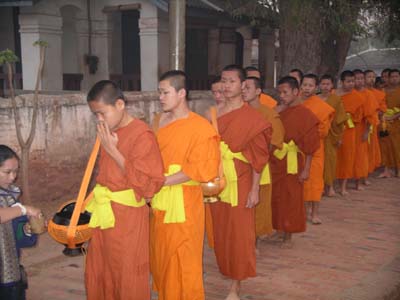 as
the 300 barefoot men and boys in bright orange robes file single file in a
big circle around the center of Luang Prabang. The local residents each put
a small handful of rice in the pots of each novice and monk as
as
the 300 barefoot men and boys in bright orange robes file single file in a
big circle around the center of Luang Prabang. The local residents each put
a small handful of rice in the pots of each novice and monk as 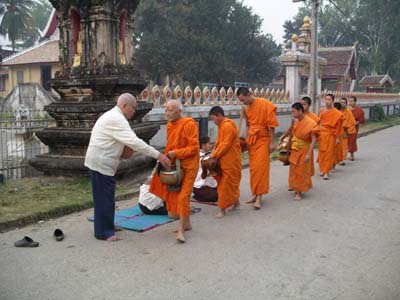 they
file by. Many of the residents said small prayers or touched the rice to their
heads before giving it to the monks. It was fascinating to observe this ages-old
tradition, and even though we were told that it was fine to take pictures,
we felt like we were intruding on something that is very important to these
people.
they
file by. Many of the residents said small prayers or touched the rice to their
heads before giving it to the monks. It was fascinating to observe this ages-old
tradition, and even though we were told that it was fine to take pictures,
we felt like we were intruding on something that is very important to these
people.
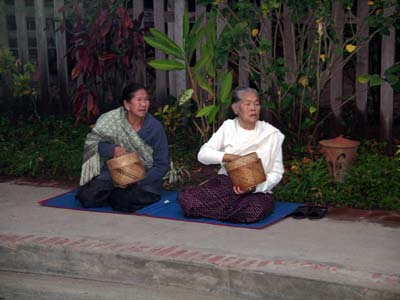 After
the procession was complete, the monks returned to their monasteries for breakfast.
In addition to the rice, the locals provide the monasteries with fruit, vegetables
and meat for breakfast and lunch. The monks eat two meals in the morning,
but are not allowed to eat again after 12:00 noon and are only allowed water
until the next morning. We learned later in the day just how important the
town is to the monasteries, essentially providing for all their needs.
After
the procession was complete, the monks returned to their monasteries for breakfast.
In addition to the rice, the locals provide the monasteries with fruit, vegetables
and meat for breakfast and lunch. The monks eat two meals in the morning,
but are not allowed to eat again after 12:00 noon and are only allowed water
until the next morning. We learned later in the day just how important the
town is to the monasteries, essentially providing for all their needs.
After our own breakfast, we met a guide to show us some of the most 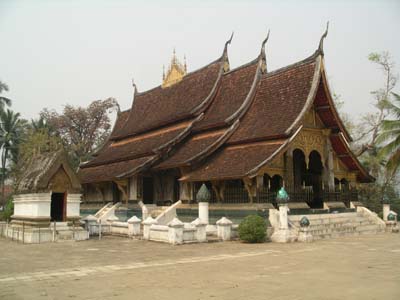 important
wats (temples). Luang Prabang has been a site for temples for 500 years and
was originally the capital of Laos. At its height there were over 60 temples
but about half were destroyed during wars. Our guide took us to three wats:
The Wat Mai (built in
important
wats (temples). Luang Prabang has been a site for temples for 500 years and
was originally the capital of Laos. At its height there were over 60 temples
but about half were destroyed during wars. Our guide took us to three wats:
The Wat Mai (built in 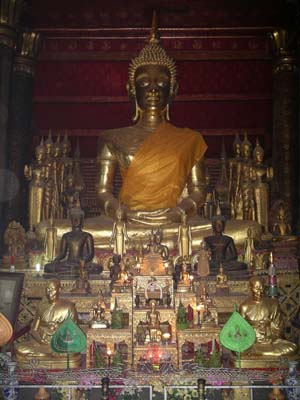 1796),
Wat Xieng Thong (built in 1560) and Visoun Wat (the oldest, built in 1513).
These temples were all outstanding and their beautiful exteriors were matched
only by the massive Buddha statutes inside. We learned what some of the different
Buddha positions signified, including suggestions of peace, rain, calm seas,
or meditation.
1796),
Wat Xieng Thong (built in 1560) and Visoun Wat (the oldest, built in 1513).
These temples were all outstanding and their beautiful exteriors were matched
only by the massive Buddha statutes inside. We learned what some of the different
Buddha positions signified, including suggestions of peace, rain, calm seas,
or meditation.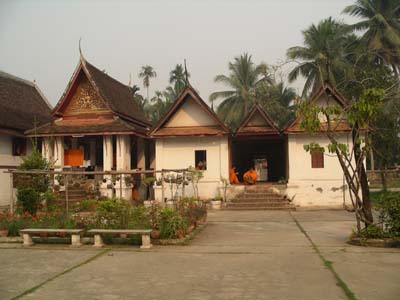
Our guide was a former novice, and was able to share with us the daily life
of the novices and monks as well as the precepts they must live by. The nuns
(female monks) and novices have 8-10 rules while the monk must live by 231
precepts! The common man is expected to live by only five of these rules.
For the monks, some of the precepts are as simple as not lying or stealing
but others are more difficult and include celibacy and living their entire
lives within the monastery. Boys can begin life at the 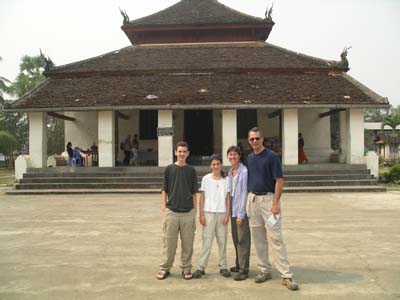 monastery
as early as 3 years old but most are 7-8 years of age. Many come to study
because their families cannot afford their education in the villages. We also
learned that it is desirable for a family to have at least one child trained
as a monk so that they can "deliver the family to paradise after their
death." Between two and three thousand monks live in Luang Prabang. In
addition to studying,
monastery
as early as 3 years old but most are 7-8 years of age. Many come to study
because their families cannot afford their education in the villages. We also
learned that it is desirable for a family to have at least one child trained
as a monk so that they can "deliver the family to paradise after their
death." Between two and three thousand monks live in Luang Prabang. In
addition to studying,  they
spend their days praying, meditating and reviewing the ancient scriptures
written on palm leaves.
they
spend their days praying, meditating and reviewing the ancient scriptures
written on palm leaves.
It was interesting to see the novices and monks both in the monasteries,
and throughout the town. In the monasteries, we saw groups socializing in
front of the wats, and around the small 1-room residences where they live.
Each monk or novice belongs to a specific wat which is where they spend most
of their time. Walking through Luang Prabang, you also see  several
orange-clad men and boys strolling the streets and shops. We even saw the
abbot for one of the wats shopping in a small local hardware store. This was
all a very new sight for us, but one that's simply part of day-to-day life
here.
several
orange-clad men and boys strolling the streets and shops. We even saw the
abbot for one of the wats shopping in a small local hardware store. This was
all a very new sight for us, but one that's simply part of day-to-day life
here.
We also enjoyed visiting several of the local markets. Here we were able
to see fresh fish, meat, vegetables and fruit being sold (very little seafood
is available - only a couple of types of fish from the Mekong River). There
were many things we had not seen before including dried seaweed leaves (from
the Mekong), unusual fruits, a woman carrying a bowl of live insects (which
are meant to be fried with eggs), in addition to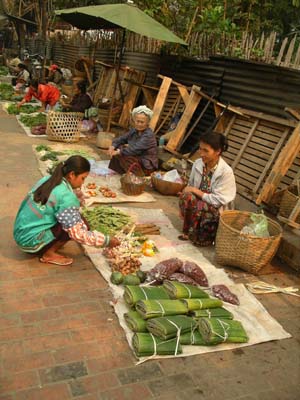 several common herbs used in Laos cooking (mint, cardamom, garlic, parsley,
cilantro). There are many meats for sale for $1.00 per pound, and their staple,
rice was 20 cents per pound.
several common herbs used in Laos cooking (mint, cardamom, garlic, parsley,
cilantro). There are many meats for sale for $1.00 per pound, and their staple,
rice was 20 cents per pound.
Laos is a very poor country, and the average annual income for people here is only $120. Doctors make closer to $500 per year. The kip (the local currency) has also been in a free-fall. The exchange rate here is 10,000 kip per dollar. Only 2-3 years ago, there were 5,000 kip per dollar, and we know that some years before that it was more like 700 kip per dollar (we plan to do some research about the exact timings involved).
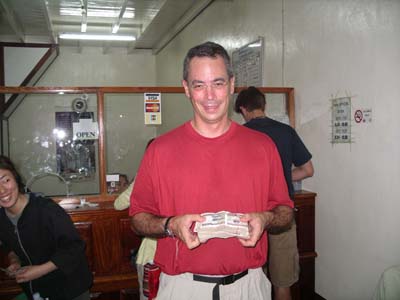 The largest kip note is 20,000, or $2.00. When we exchanged $200 in traveler's
checks for kip, we were handed a 6-inch stack of 5,000 kip notes! We asked
for larger bills, but were told that these are the bills that are used here.
Since the bills won't fit in Steve's pocket, we have had to split them among
the 4 of us (explaining the pained look on Steve's face)…
The largest kip note is 20,000, or $2.00. When we exchanged $200 in traveler's
checks for kip, we were handed a 6-inch stack of 5,000 kip notes! We asked
for larger bills, but were told that these are the bills that are used here.
Since the bills won't fit in Steve's pocket, we have had to split them among
the 4 of us (explaining the pained look on Steve's face)…
The exchange rate and economy here have made Laos by far the least expensive
place we have visited. Even in the tourist-oriented restaurants, it's hard
to spend over $20 for a meal for the 4 of us. At local restaurants the total
bill comes to around $10. When we leave tips of $2-3 at restaurants, the waiters
hand us the money back thinking we've made a mistake in tipping that much.
We had a local service wash and dry all our clothes - the total came to $10.
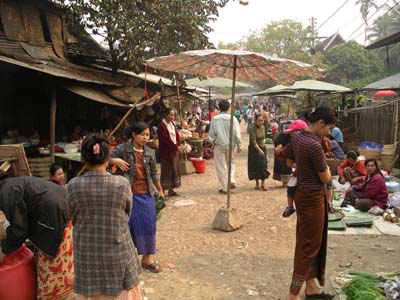
The average annual income here is $120 and that even doctors and teachers only make about $40/month. However, similar to Vietnam, we haven't seen any signs of extreme poverty, and no one begs for money on the streets. Local merchants, many with large amounts of silk products for sale, are never overly-pushy.
We had fun shopping for the traditional Laos skirts worn by all the women here - they are beautiful wrapped skirts with wide silk trims. Katie and Paula selected material which a tailor will make into our skirts and have ready for us by tomorrow! We also purchased several other smaller souvenirs.
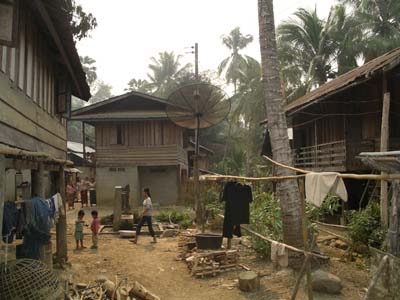 After
having a traditional Lao meal for lunch - sticky rice, fried noodles, laap
(finely cut meat and fish - we headed 15 kilometers outside the town to visit
a low-land village. We were joined for our main guide for the week, Nit. Nit
After
having a traditional Lao meal for lunch - sticky rice, fried noodles, laap
(finely cut meat and fish - we headed 15 kilometers outside the town to visit
a low-land village. We were joined for our main guide for the week, Nit. Nit
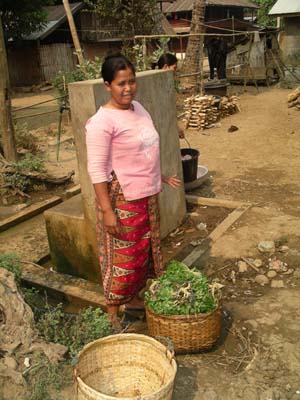 explained
to us that people in Laos are grouped into low-landers (living by the river),
high-landers (living high in the mountains) and mid-landers (those living
in the middle). Our visit to the low-land village of Banxath, as expected,
was the highlight of our day.
explained
to us that people in Laos are grouped into low-landers (living by the river),
high-landers (living high in the mountains) and mid-landers (those living
in the middle). Our visit to the low-land village of Banxath, as expected,
was the highlight of our day.
Two hundred and fifty people live in this village, and focus mostly on farming.
They have a small stream and dam which provides electricity. These people
live very simply in small stone single-room homes with tin or thatched roofs.
There is one small store, a 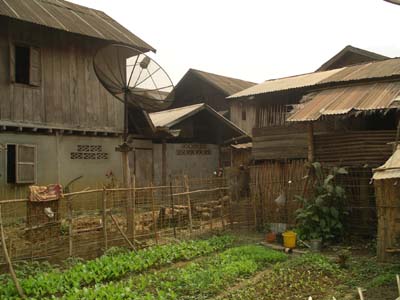 temple,
and a building that's used for village meetings (arranged by the chief of
the village). That's it. No tourists stop here, and one older woman asked
Nit why we had come (of course, we had specifically asked Nit to take us to
a place not frequented by tourists - many of the "craft villages"
that people are taken to are actually planned tourist places that focus on
selling product to visitors).
temple,
and a building that's used for village meetings (arranged by the chief of
the village). That's it. No tourists stop here, and one older woman asked
Nit why we had come (of course, we had specifically asked Nit to take us to
a place not frequented by tourists - many of the "craft villages"
that people are taken to are actually planned tourist places that focus on
selling product to visitors).
We stopped to talk with some of the people working and learned about the
crops they grow and how they sell them in the markets. We even purchased a
very large papaya. We saw baskets of vegetables prepared for the market and
large bunches of herbs which would be sold for only 10 cents. The huge amount
of work required to pick and bundle these herbs was evident, as we watched
several women getting the product ready for market. 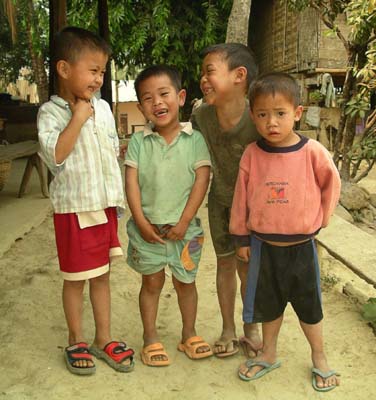 Typically,
the residents work in the gardens during the day, and then hire a tuk-tuk
to take them to the Luang Prabang vegetable markets in the afternoon. They
then return to the village after they have sold their products each day.
Typically,
the residents work in the gardens during the day, and then hire a tuk-tuk
to take them to the Luang Prabang vegetable markets in the afternoon. They
then return to the village after they have sold their products each day.
The only modern luxury for the people in the villages is TV. Every home seemed
to have its own television, and we at least 10 satellite dishes here, often
planted in the middle of gardens or between small homes. Lao television is
controlled by the government, and consists only of censored news and documentary
programs. As Nit told us, there's really not much to 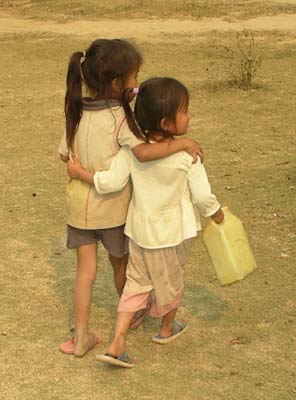 watch
on Lao TV. Instead, the satellites are used to access broadcasts from Thailand,
containing a wide variety of modern shows, sports and news programs. Since
the Thai language is similar to the Lao that's spoken here, this works well
for the local residents.
watch
on Lao TV. Instead, the satellites are used to access broadcasts from Thailand,
containing a wide variety of modern shows, sports and news programs. Since
the Thai language is similar to the Lao that's spoken here, this works well
for the local residents.
Slowly, the children of the village began to follow us out of curiosity.
When we asked a group of small boys if we could take their picture, their
eyes lit up and we immediately had friends. The boys were especially fond
of David and before we knew it they convinced him to help them reach fruit
(using a long pole) that was growing in the trees out of their reach. Then
they played soccer with some of the fallen fruit and giggled  nonstop.
Several small girls watched nearby, but seemed too shy to join in the fun.
Nit told us that the local people call us "people with long noses,"
and that everyone comments about our height and fair skin color.
nonstop.
Several small girls watched nearby, but seemed too shy to join in the fun.
Nit told us that the local people call us "people with long noses,"
and that everyone comments about our height and fair skin color.
We learned that families in Laos are quite large, often 10-12 children per couple, especially in the villages. Average family sizes are 5-7 children, and birth rates in Laos are growing rapidly. Women marry at age 14-15. The villages often share a small primary school for children ages 7-12 years but after this the children must travel into the city for a secondary education and to the university in Vientiane. Nit indicated that many of the children will not go to school beyond age 12 and virtually no one will go to the university from these villages.
 After
playing with the children in the orchards, we made our way back toward the
village past the village temple where the monks were chanting prayers. As
we looked up, David two little boys holding his hands leading him through
the village. As we caught up with them, our guide told us that they were telling
David that they wanted him to see their garden. We were more than happy to
follow. They took us outside the village center and we were soon walking in
the dry terraced rice paddies (in this area, they won't be able to plant rice
until the rains begin in June). The boys showed David how they make a game
of throwing rocks and using buffalo dung as their targets. They also told
him they wanted to give him a present - one of their water buffalo! Water
buffalo are valuable possessions here, so we guess David had really made good
friends.
After
playing with the children in the orchards, we made our way back toward the
village past the village temple where the monks were chanting prayers. As
we looked up, David two little boys holding his hands leading him through
the village. As we caught up with them, our guide told us that they were telling
David that they wanted him to see their garden. We were more than happy to
follow. They took us outside the village center and we were soon walking in
the dry terraced rice paddies (in this area, they won't be able to plant rice
until the rains begin in June). The boys showed David how they make a game
of throwing rocks and using buffalo dung as their targets. They also told
him they wanted to give him a present - one of their water buffalo! Water
buffalo are valuable possessions here, so we guess David had really made good
friends. 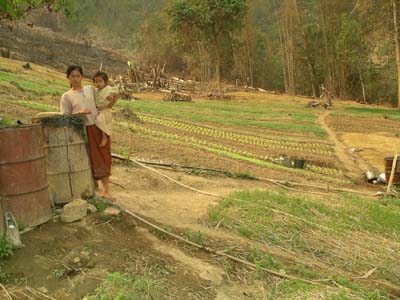
We walked through the fields and then up into the bamboo and teak wood forest for 10-15 minutes before we reached a large clearing and the boys' garden. They proudly named the crops growing and showed us how they helped their family water the garden everyday with water buckets. We also saw that their family was burning some of the land to extend their garden.
Unfortunately, during the dry season (which starts now), people all over
Laos routinely burn forest area in order to clear land for planting vegetables,
rice or teak wood. The air here is particularly hazy now as a result of these
fires, and we were 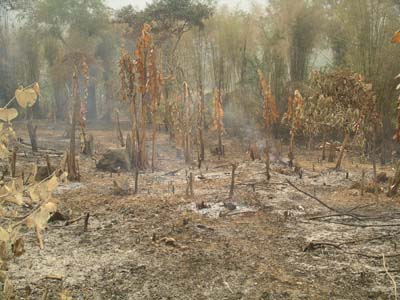 able
to see many of areas burning today. Interestingly, Laotians who live outside
the larger cities and towns are able to use whatever land want, either for
building homes or farming. Nit indicated that the
able
to see many of areas burning today. Interestingly, Laotians who live outside
the larger cities and towns are able to use whatever land want, either for
building homes or farming. Nit indicated that the government is trying to get people to stop doing this but that it has been
very difficult to stop this practice (the haze is clear in this picture with
Katie).
government is trying to get people to stop doing this but that it has been
very difficult to stop this practice (the haze is clear in this picture with
Katie).
When we finally decided it was time to leave, the boys escorted us all they way back to the village center. As we loaded the van, all the children came out to bid us farewell, chasing us and waving until we were out of sight.
This evening we spent some time wandering through the streets of Luang Prabang. The stores, businesses and restaurants here also function as people's homes. As we peered inside, we saw entire families relaxing in front of their televisions. The storefronts remained open just in case the odd sale happened to walk by. Everyone watches TV, and we've learned that no one reads books. In fact, there's only one newspaper in Laos (published in Vientiane), and Nit told us that it comes out only weekly. She also told us that the locals often comment when they see foreigners reading books here.
We have found our first day here to be fascinating - Laos is a very different country than Vietnam, and we look forward to understanding more about life here during the next several days. Tomorrow we'll be visiting another village, and making a trip to an area with beautiful waterfalls.
